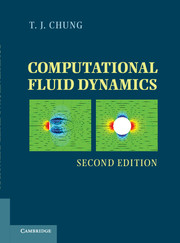Book contents
- Frontmatter
- Contents
- Preface to the First Edition
- Preface to the Revised Second Edition
- Part One Preliminaries
- Part Two Finite Difference Methods
- Chapter Three Derivation of Finite Difference Equations
- Chapter Four Solution Methods of Finite Difference Equations
- Chapter Five Incompressible Viscous Flows via Finite Difference Methods
- Chapter Six Compressible Flows via Finite Difference Methods
- Chapter Seven Finite Volume Methods via Finite Difference Methods
- Part Three Finite Element Methods
- Part Four Automatic Grid Generation, Adaptive Methods, and Computing Techniques
- Part Five Applications
- Appendixes
- Index
- References
Chapter Six - Compressible Flows via Finite Difference Methods
from Part Two - Finite Difference Methods
Published online by Cambridge University Press: 05 June 2012
- Frontmatter
- Contents
- Preface to the First Edition
- Preface to the Revised Second Edition
- Part One Preliminaries
- Part Two Finite Difference Methods
- Chapter Three Derivation of Finite Difference Equations
- Chapter Four Solution Methods of Finite Difference Equations
- Chapter Five Incompressible Viscous Flows via Finite Difference Methods
- Chapter Six Compressible Flows via Finite Difference Methods
- Chapter Seven Finite Volume Methods via Finite Difference Methods
- Part Three Finite Element Methods
- Part Four Automatic Grid Generation, Adaptive Methods, and Computing Techniques
- Part Five Applications
- Appendixes
- Index
- References
Summary
In general, the physical behavior of compressible flows is more complicated than in incompressible flows. Compressible flows may be viscous or inviscid, depending on flow velocities. Compressible inviscid flows are analyzed using the potential or Euler equations, whereas compressible viscous flows are solved from the Navier-Stokes system of equations. Shock waves may occur in compressible flows and require special attention as to the solution methods. Furthermore, shock wave turbulent boundary layer interactions in compressible viscous flows constitute one of the most important physical phenomena in computational fluid dynamics. Let us consider air flows at speeds greater than 100 m/s, which corresponds to a Mach number of approximately 0.3, but less than 1700 m/s, or approximately Mach 5. Air flows in this range (0.3 ≤ M ≤ 5) may be considered as compressible and inviscid. This range is usually subdivided into regions identified as subsonic (0.3 < M < 0.8), transonic (0.8 ≤ M ≤ 1.2), and supersonic (1.2 < M ≤ 5). For M > 5, the flow is referred to as hypersonic. Hypersonic flows around a solid body are usually coupled with viscous boundary layers. Effects of dilatational dissipation due to compressibility, high temperature gradients, vortical motions within the secondary boundary layers, radiative heat transfer, vibrational and electronic energies, and chemical reactions are examples of some of the complex physical phenomena associated with hypersonic flows.
In order to take into account the compressibility and variations of density in high-speed flows, we utilize the conservation form of the governing equations, using the density-based formulation. This is in contrast to the pressure-based formulation for incompressible flows discussed in Chapter 5. For compressible flows, we encounter some regions of the flow domain (close to the wall, for example) in which low Mach numbers or incompressible flows prevail. In this case, the density-based formulations become ineffective, with the solution convergence being extremely slow. To resolve such problems, various schemes have been developed. Among them are the preconditioning process for the time-dependent term toward improving the stiff convection eigenvalues and the flowfield-dependent variation (FDV) methods allowing the transitions and interactions of various flow properties as well as all speed flows.
Information
- Type
- Chapter
- Information
- Computational Fluid Dynamics , pp. 120 - 217Publisher: Cambridge University PressPrint publication year: 2010
